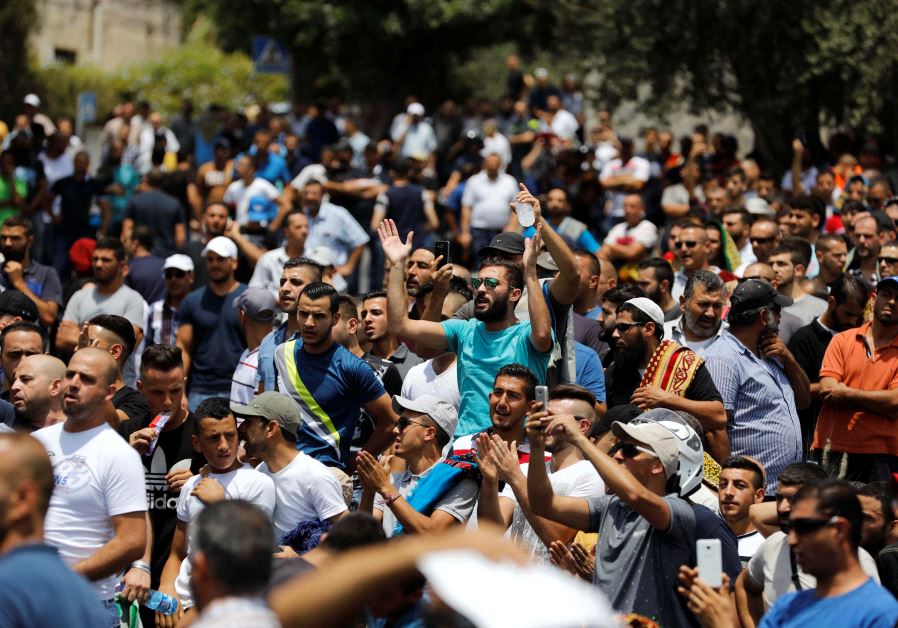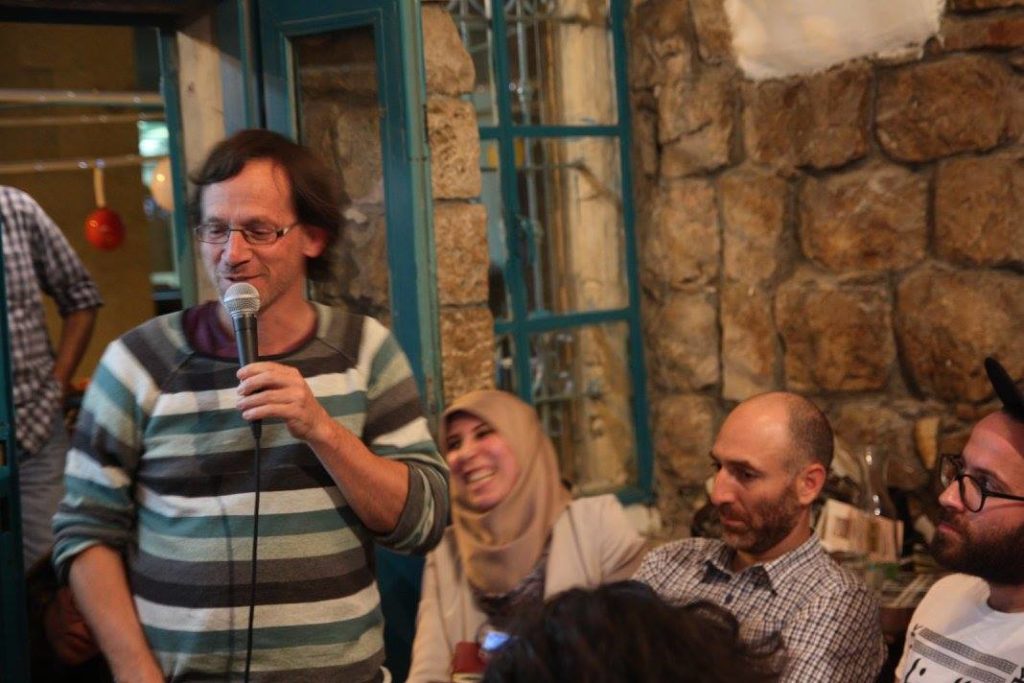Victory for Non-Violent Protest
NONVIOLENCE, ACTIVISM, PALESTINE - ISRAEL, 7 Aug 2017
Jews for Justice for Palestinians – TRANSCEND Media Service
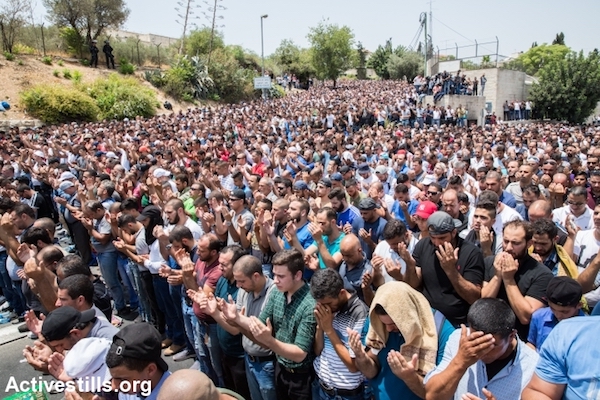
Palestinian worshippers hold a mass prayer in the streets of East Jerusalem as an act of civil disobedience after Israel implemented new entry arrangements for Al-Aqsa Mosque, July 21, 2017.
Photo by Yotam Ronen/Activestills.org
Mass protests over Temple Mount carve out unique civil disobedience
Messages of nonviolence coupled with angry chants restrained youth last week, but can Islamic preachers keep the balance?
By Seth Frantzman, JPost
July 23, 2017
A man passed out sugar-drenched tea in paper cups, one by one, to crowds of young men on Friday night next to the Gate of the Tribes outside Jerusalem’s Temple Mount. As he did, hundreds chanted Islamic refrains to a preacher perched above on a roof haranguing those present.
“Allahu akbar,” they said combined with synchronized clapping overhead.
“Khaybar, Khaybar, ya yahud, Jaish Muhammad, sa yahud,” was another favourite, which means, “Remember Khaybar, you Jews, the army of Muhammad is returning,” a reference to a battle and massacre of Jews in the seventh century. When Special Patrol Unit (Yasam) riot police marched by, the energized crowd pushed to close the way, but the preacher asked them to show restraint. There would be no violence.
The combination of protests and mass prayer that have come to the precipice of rioting every night for a week since the terrorist attack on July 14, and orchestrated attempts to keep violence from spilling over have become hallmarks of a unique civil disobedience in response to the addition of metal detectors at gates to the Temple Mount and compound around al-Aksa Mosque. Since the attack that killed two Israeli policemen, there have been calls from the West Bank Palestinian leadership for a “day of rage” and from Hamas in Gaza for attacks on Israelis. Arab Knesset member Taleb Abu Arar has claimed a third intifada is on the way, but Jerusalem’s local religious leadership has responded differently so far.
On Saturday, east Jerusalem was mostly quiet as the focus was on the aftermath of a terrorist attack in Neveh Tzuf (Halamish) in the West Bank.
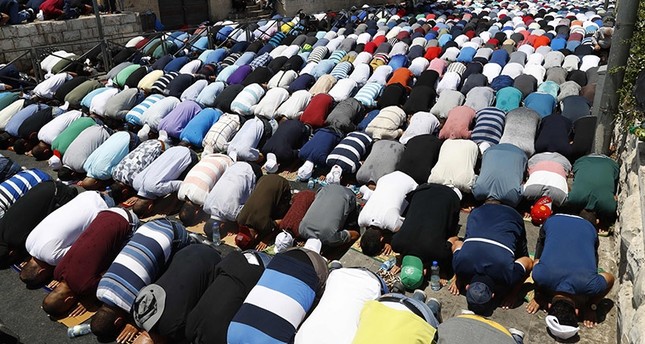
Palestinian Muslim worshippers pray outside occupied East Jerusalem’s Al-Aqsa Mosque compound as Israel barred men under 50 from entering the site on July 28, 2017. Photo by AFP
Since the July 14 attack, men gathered for mass prayer at security cordons around the Old City, concentrating at Lions’ Gate, which worshipers from parts of east Jerusalem use to get to enter the Old City on their way to the Temple Mount. Whereas Damascus Gate is often used by people coming from farther away, Lions’ Gate is used by locals from adjacent areas such as Silwan and A-Tur. The Gate of the Tribes to the Mount, just inside Lions’ Gate, has become a focal point for nightly protests.
While police have increasingly restricted those holding mass prayers outside Lions’ Gate or farther afield, such as near A-Tur, from entering the Old City because of fear of violence, residents of the Old City, tourists from abroad, Red Crescent volunteers, and some young men who have been staying in the city, gather nightly along the road that leads from Lions’ Gate to the Via Dolorosa. There is a parking lot here and a small square called el-Ghazali that is built on top of an ancient pool called Birkat Bani Israel, or the Pool of the Tribes of Israel. Across from the square is the Church of St. Anne.
Although there have been clashes here during the last week, the general trend has been toward nonviolent prayer-protest. The profoundly religious aspect of this protest can be seen in the lack of Palestinian flags or outward political affiliation of the attendees. On Wednesday a dozen young men chanted against Palestinian Authority President Mahmud Abbas, but in general political speeches have been rare and religious preaching has been common.
A video from the protest is posted on the YouTube channel Aqsa Call, which is often shared on Twitter by accounts associated with Hizb ut-Tahrir, an international pan-Islamist organization that has followers in Jerusalem.
The generally peaceful prayers and protests ended on Friday around 10 p.m. and men filed home. A Turkish tour group took selfies with a young kid standing a chair shouting “Allahu akbar” at police. One young man was detained in scuffles with Israeli riot police, but otherwise the crowd and the riot police seemed to understand one another. An invisible red line separates acceptable chanting and anti-Jewish chants, from clashes. This quiet understanding has been on display as police have even moved barricades to accommodate men who place prayer rugs in long lines to pray and avoided walking among them while they do.
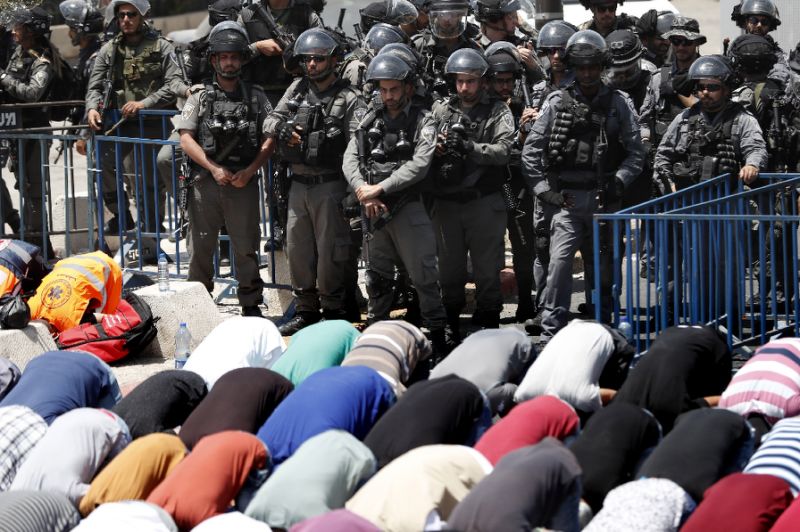
Israeli border police, dressed for a riot, end up watching Palestinian men pray outside Jerusalem’s Old City overlooking the Al-Aqsa mosque compound on July 28, 2017. Photo by Ahmad Gharabli/AFP
For a week Jerusalem’s worshippers have carved out this space and the police have allowed it to continue with slight changes in regulations each night, such as restricting access to the Old City by age or by residency. The preachers who attend have successfully corralled hundreds of young men into prayer, rather than running street battles.
************************************
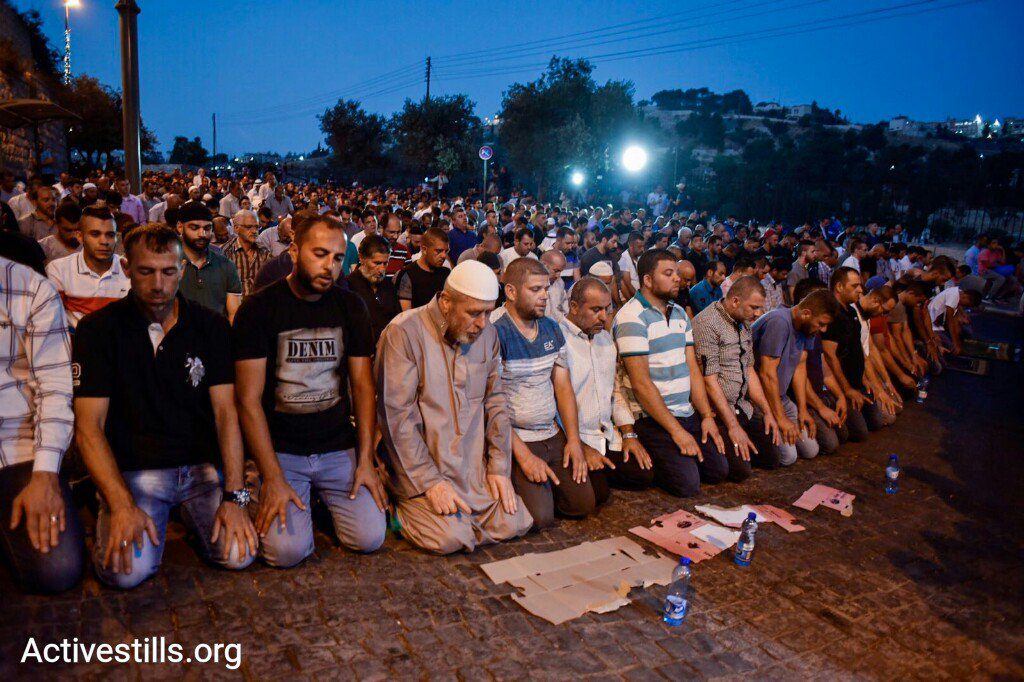
Palestinian worshippers hold a mass prayer in the streets of East Jerusalem as an act of civil disobedience after Israel implemented new entry arrangements for Al-Aqsa Mosque, Wadi Joz, East Jerusalem, July 21, 2017.
Photo by Yotam Ronen/Activestills.org
How the world missed a week of Palestinian civil disobedience
The violence of the past week, and the media’s coverage of the bloodletting, erased a central aspect of the story: Palestinian mass civil disobedience.
By Edo Konrad, +972
July 24, 2017
For many Israelis, the violence over the past few weeks around the Temple Mount/Haram al-Sharif is little more than a result of Muslim intransigence in the face of legitimate Israeli security concerns. This, after all, has been the major talking point among both the Israeli leadership as well as the media. For Palestinians, on the other hand, the metal detectors erected last week by Israeli authorities at the entrance to the Al-Aqsa compound sparked outrage and protests.
That outrage stemmed from the government’s decision to instal the metal detectors — in defiance of both the IDF and the Shin Bet’s recommendation — that eventually led to the deaths of four Palestinian protesters at the hands of Israeli security forces, and the brutal murder of three Israeli settlers by a Palestinian attacker that same night. But the violence, and the media’s coverage of the bloodletting, erased a central aspect of the story: Palestinian civil disobedience.
“We need to understand that there has been a major, continuous nonviolent protest taking place in East Jerusalem for over a week,” says Aviv Tatarsky, a field researcher for Ir Amim, a Jerusalem-based NGO that works to build a more equitable city for all its residents. “The decision to boycott the metal detectors and refrain from going up to Al-Aqsa, the continuous stream of people to the gates of the compound, the mass prayers, all of these are a form of civil disobedience. And as such, it is a legitimate form of protest — whether or not we agree with it.”
“For Israelis, framing the protests in East Jerusalem as ‘nonviolent’ is at best strange and at worst scandalous, since the metal detectors were installed following the killing of Border Police officers at the site two weeks ago, and because three Israelis were murdered just a few days ago,” Tatarsky continues. “But in order to understand the nonviolence of the protests, the Israeli public will have to differentiate between the actions of individuals — who aren’t even from East Jerusalem — and the mass protest movement that includes most parts of Palestinian civil society in Jerusalem.”
+972 Magazine spoke to Tatarsky about the delicate status quo at the Temple Mount, the possibility of bringing an end to the violence, and the media’s unwillingness to cover Palestinian nonviolence.
What do the events of the past week look like from the Palestinian side?
Every Palestinian knows what it feels like when Israeli security measures restrict their freedoms and violate their rights — often for no reason. From random checks in the middle of the street to checkpoints to shutting down entire neighbourhoods. The metal detectors were installed after two days in which Palestinians were barred from entering the Old City, all while Jews and tourists were free to enter and exit. Most Israelis cannot comprehend that what they view as legitimate “security measures” is in the eyes of Palestinians a form of collective punishment.
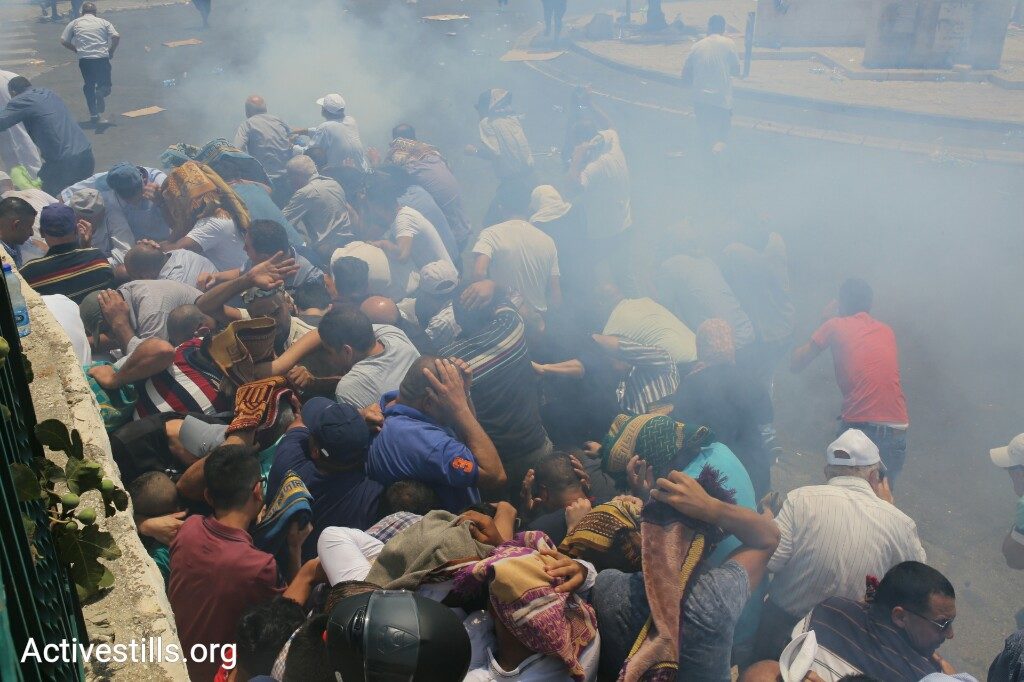
Israeli forces fire tear gas at Palestinian worshippers in Ras al-Amud, East Jerusalem, July 21, 2017. Photo by Oren Ziv/Activestills.org
Remember that it is easy for violence to break out in a tense situation in which Israeli armed forces are standing face-to-face with angry Palestinian protesters. Sometimes it is the police who are the ones who initiate the violence, other times it is the demonstrators. Regardless, a central component of the protests was practicing nonviolence on a daily basis, all while bravely standing up to armed security forces that could use violence at any point.
What is this ‘status quo’ that we keep hearing so much about?
Since 1967, the Waqf has been in charge of overseeing entry to the Temple Mount/Haram al-Sharif. The metal detectors manned by Israeli security personnel takes that authority away from the Waqf, which is effectively a change in the status quo. Until 2000, when the Second Intifada broke out, the Waqf decided who could or couldn’t enter the Temple Mount/Haram al-Sharif.
In 2003, when Israel began re-allowing non-Muslim access to the site, after it was halted with the eruption of the Intifada, it took away the Waqf’s authority over the Mughrabi Gate, through which non-Muslims enter the site.
Since then, and especially since the rise in clashes between security forces and Palestinians over the past few years — usually as a response to Jews ascending the Mount — members of the Waqf have repeatedly demanded that the authority be returned to them, even going so far as to propose alleviating entry conditions for Jews. With the metal detectors, the Waqf believes the police have further stifled its control over the entry to the Mount.
Why didn’t the Israeli public pay attention to the nonviolent protests?
I believe it has to do with the fact that the Israeli media totally missed the nonviolent aspect of the protests. One can assume that Israeli journalists suffer from the same prejudice as the rest of the public: they are so sure that Palestinian resistance automatically means violence, that they are unable to identify other expressions of it.
Let’s not forget that the media played a role in this crisis. Yes, the Israeli government is the one that made the wrong decision to put up the metal detectors, and thus is responsible for refusing to remove them. But when politicians act irresponsibly, the public has the right to demand that they change their decisions.
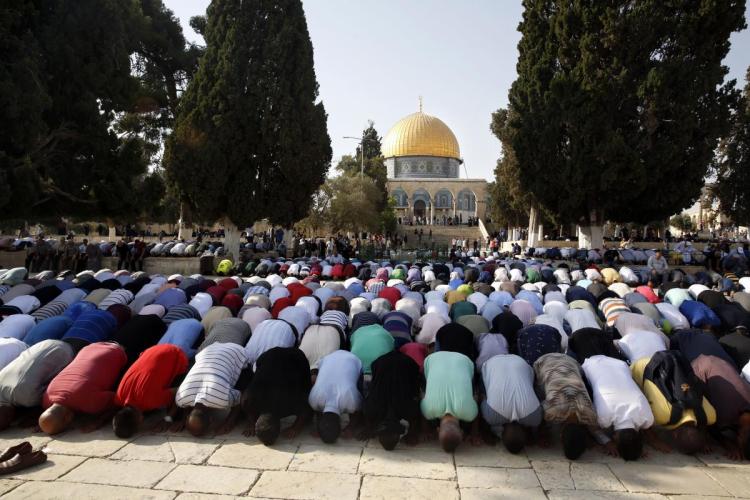
Palestinians pray inside the Al Aqsa Mosque compound in Jerusalem’s Old City on Thursday, July 27, 2017. Israeli Prime Minister Benjamin Netanyahu has ordered police reinforcements deployed to Jerusalem following clashes at a flashpoint holy site. Photo by Mahmoud Illean
Had the Israeli public been told about the nonviolent aspects of the protest, some segments of the population would have understood that civil disobedience is a legitimate way to make political demands. In a situation of nonviolent protest, negotiations with the representatives of the protesters is a desired outcome.
However, removing the metal detectors as a result of a violent struggle is akin to “capitulating to terror.” In this scenario, there was simply no possibility for the Jewish Israeli public to put pressure on the government to remove the metal detectors.
What is the status of the nonviolent demonstrations now?
The majority of Palestinians in East Jerusalem are maintaining restraint. Despite the violent clashes, the mass nonviolent prayers continue to be one of the central components of the protest. It could very well be that even now, finding a solution to the metal detectors will bring about calm and a halt to the violence.
Is that even feasible at this point?
It’s hard to suggest such a solution. Regardless of our opinion on the best possible outcome, it is easy to see that the two sides will find it difficult to agree to an arrangement that portrays them as the loser in this round. On the other hand, as long as the two sides double down, the crisis may continue and escalate.
The bottom line, however, is this: Israel cannot unilaterally make decisions about entry to the Temple Mount/Haram al-Sharif. Coordination with the Waqf is necessary since it both protects the rights of Muslim worshippers and because of the legitimacy it grants the Waqf among the Muslim public. Coordination also means recognizing the Waqf’s authority at the Temple Mount/Haram al-Sharif.
The violence in Jerusalem over the past few years is an expression of the weakness of the leadership in East Jerusalem, which still holds sway over much of the Palestinian public in the city, and with the Israeli authorities could have held a dialogue. Israel pays a price for this weakness every time a crisis arises. The current crisis is leading to a new, popular leadership in East Jerusalem. If Israel understands that it must be in dialogue with it, the crisis may yet let to a positive change in the city.
____________________________________________
 Jews for Justice for Palestinians is a network of Jews who are British or live in Britain, practising and secular, Zionist and not. We oppose Israeli policies that undermine the livelihoods, human, civil and political rights of the Palestinian people. We support the right of Israelis to live in freedom and security within Israel’s 1967 borders. We work to build world-wide Jewish opposition to the Israeli Occupation, with like-minded groups around the world and are a founding member of European Jews for a Just Peace, a federation of Jewish groups in ten European countries.
Jews for Justice for Palestinians is a network of Jews who are British or live in Britain, practising and secular, Zionist and not. We oppose Israeli policies that undermine the livelihoods, human, civil and political rights of the Palestinian people. We support the right of Israelis to live in freedom and security within Israel’s 1967 borders. We work to build world-wide Jewish opposition to the Israeli Occupation, with like-minded groups around the world and are a founding member of European Jews for a Just Peace, a federation of Jewish groups in ten European countries.
Join the BDS-BOYCOTT, DIVESTMENT, SANCTIONS campaign to protest the Israeli barbaric siege of Gaza, illegal occupation of the Palestine nation’s territory, the apartheid wall, its inhuman and degrading treatment of the Palestinian people, and the more than 7,000 Palestinian men, women, elderly and children arbitrarily locked up in Israeli prisons.
DON’T BUY PRODUCTS WHOSE BARCODE STARTS WITH 729, which indicates that it is produced in Israel. DO YOUR PART! MAKE A DIFFERENCE!
7 2 9: BOYCOTT FOR JUSTICE!
DISCLAIMER: The statements, views and opinions expressed in pieces republished here are solely those of the authors and do not necessarily represent those of TMS. In accordance with title 17 U.S.C. section 107, this material is distributed without profit to those who have expressed a prior interest in receiving the included information for research and educational purposes. TMS has no affiliation whatsoever with the originator of this article nor is TMS endorsed or sponsored by the originator. “GO TO ORIGINAL” links are provided as a convenience to our readers and allow for verification of authenticity. However, as originating pages are often updated by their originating host sites, the versions posted may not match the versions our readers view when clicking the “GO TO ORIGINAL” links. This site contains copyrighted material the use of which has not always been specifically authorized by the copyright owner. We are making such material available in our efforts to advance understanding of environmental, political, human rights, economic, democracy, scientific, and social justice issues, etc. We believe this constitutes a ‘fair use’ of any such copyrighted material as provided for in section 107 of the US Copyright Law. In accordance with Title 17 U.S.C. Section 107, the material on this site is distributed without profit to those who have expressed a prior interest in receiving the included information for research and educational purposes. For more information go to: http://www.law.cornell.edu/uscode/17/107.shtml. If you wish to use copyrighted material from this site for purposes of your own that go beyond ‘fair use’, you must obtain permission from the copyright owner.
Read more
Click here to go to the current weekly digest or pick another article:
NONVIOLENCE:
- Town Hall Violence and a (Hypothetical) Nonviolent Response
- Can Nonviolent Struggle Defeat a Dictator? This Database Emphatically Says Yes
- A Nonviolent Resistance Movement Is at Work in Palestine--Activists Say It’s the Only Way Forward
ACTIVISM:
- Act Now against These Companies Profiting from the Genocide of the Palestinian People
- Conscientious Objectors Refuse to Enlist in the Israeli Army: “Get Out of Gaza Now!”
- Lee Lakeman and the Whoredom of the Left
PALESTINE - ISRAEL:
